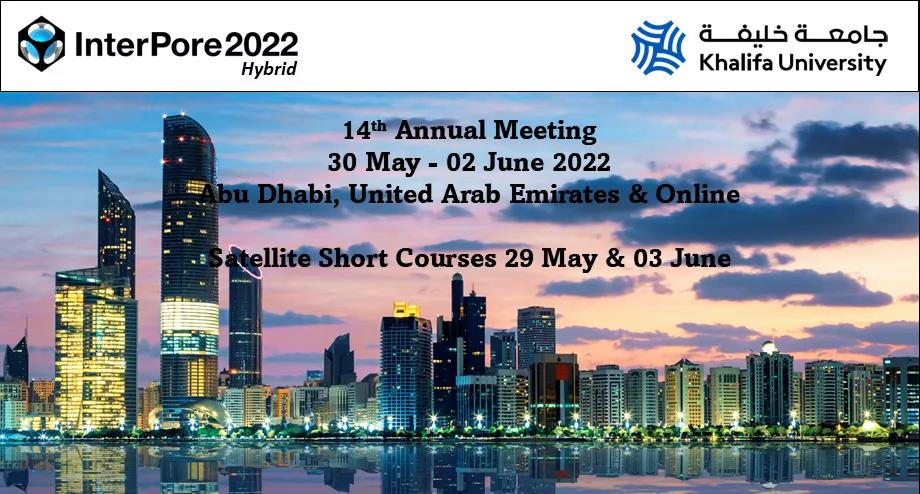Reactive transport modeling of water-CO₂-rock interactions in clay-coated sandstones and implications for CO₂ storage
Abstract view|378|times PDF download|120|times Supplements download|44|times
Abstract
In this work, the potential influences of grain-coating clays on water-CO₂-rock interactions in sandstones and subsequent ramifications for CO₂ storage were investigated using reactive transport simulations. The results indicated that, compared to pore-filling smectite, grain-coating smectite leads to significant pH decrease, increases in the CO₂-species concentrations, and decreases in smectite dissolution and the precipitation of secondary minerals. Moreover, it was revealed that smectite and chlorite coats dissolve preferentially over detrital K-feldspar being covered, while K-feldspar is dissolved preferentially over illite and kaolinite coats. While the mineral trapping mechanism is only important for smectite and chlorite coats, sandstone porosity is significantly reduced for chlorite coat but increased for the other three clay coats. The main causes of the differences between pore-filling and grain-coating scenarios for smectite and chlorite coats are ascribed to the inhibitory effect of clay coats on the growth of secondary quartz and the dissolution of clay. In addition to the above two factors, the decelerating effect of clay coats on the dissolution of K-feldspar is also important for illite coat; meanwhile, for the kaolinite coat, the dissolution of clay is less important and the other two factors are more critical. Furthermore, the coverage and thickness of clay coats, fluid flow rate, detrital grain size, detrital lithology, partial pressure of CO₂, and temperature may all impact the role of clay coats.
Document Type: Original article
Cited as: Li, H., Hu, Q., Zhu, R., Liu, B., Mishara, A., Ansah, E. O. Reactive transport modeling of water-CO₂-rock interactions in clay-coated sandstones and implications for CO₂ storage. Advances in Geo-Energy Research, 2025, 17(2): 121-134. https://doi.org/10.46690/ager.2025.08.04
Keywords
References
Akinlotan, O. O., Moghalu, O. A., Hatter, S. J., et al. Paleoclimatic controls on clay mineral distribution in the Early Cretaceous (Barremian): The Wessex Basin, Southeast England. Journal of Earth Science, 2024, 35, 2050-2066.
Alansari, A., Salim, A. M. A., Janjuhah, H. T., et al. Quantification of clay mineral microporosity and its application to water saturation and effective porosity estimation: A case study from Upper Ordovician reservoir, Libya. Journal of Natural Gas Geoscience, 2019, 4(3): 139-150.
Beckingham, L. E., Mitnick, E. H., Steefel, C. I., et al. Evaluation of mineral reactive surface area estimates for prediction of reactivity of a multi-mineral sediment. Geochimica et Cosmochimica Acta, 2016, 188: 310-329.
Beckingham, L. E., Steefel, C. I., Swift, A. M., et al. Evaluation of accessible mineral surface areas for improved prediction of mineral reaction rates in porous media. Geochimica et Cosmochimica Acta, 2017, 205: 31-49.
Bethke, C. M. Geochemical and Biogeochemical Reaction Modelling. Cambridge, UK, Cambridge University Press, 2008. Black, J. R., Haese, R. R. Chlorite dissolution rates under CO2 saturated conditions from 50 to 120 ◦C and 120 to 200 bar CO2. Geochimica et Cosmochimica Acta, 2014, 125: 225-240.
Blondes, M. S., Gans, K. D., Engle, M. A., et al. U. S. Geological Survey National Produced Waters Geochem ical Database (ver. 2.3, January 2018). U.S. Geological Survey data release, 2018.
Daval, D., Martinez, I., Corvisier, J., et al. Carbonation of Cabearing silicates, the case of wollastonite: Experimental investigations and kinetic modeling. Chemical Geology, 2009, 265(1-2): 63-78.
Delany, J. M., Lundeen, S. R. The LLNL Thermochemical Database. San Francisco, Lawrence Livermore National Laboratory Report UCRL-21658, 1990.
Emmanuel, S. Modeling the effect of mineral armoring on the rates of coupled dissolution-precipitation reactions: Implications for chemical weathering. Chemical Geology, 2022, 601: 120868.
Fetter, C. W. Applied Hydrogeology Fourth Edition. USA, Pearson Education Limited, 2014.
Folk, R. L. Petrology of Sedimentary Rocks. Texas, Hemphill Publishing Company, 1974.
Giles, M. R. Mass transfer and problems of secondary porosity creation in deeply buried hydrocarbon reservoirs. Marine and Petroleum Geology, 1987, 4(3): 188-204.
Golubev, S. V., Bénézeth, P., Schott, J., et al. Siderite dissolution kinetics in acidic aqueous solutions from 25 to 100 ◦C and 0 to 50 atm pCO2. Chemical Geology, 2009, 265(1-2): 13-19.
Gong, L., Gao, X., Qu, F., et al. Reservoir quality and controlling mechanism of the Upper Paleogene fine grained sandstones in lacustrine basin in the hinterlands of Northern Qaidam Basin, NW China. Journal of Earth Science, 2023, 34: 806-823.
Helgeson, H. C. Thermodynamics of hydrothermal systems at elevated temperatures and pressures. American Journal of Science, 1969, 267(7): 729-804.
Helgeson, H. C., Knox, A. M., Owens, C. E., et al. Petroleum, oil field waters, and authigenic mineral assemblages: Are they in metastable equilibrium in hydrocarbon reservoirs? Geochimica et Cosmochimica Acta, 1993, 57(14): 3295-3339.
Higgs, K. E., Haese, R. R., Golding, S. D., et al. The Pretty Hill Formation as a natural analogue for CO2 storage: An investigation of mineralogical and isotopic changes associated with sandstones exposed to low, intermediate and high CO2 concentrations over geological time. Chemical Geology, 2015, 399: 36-64.
Hodson, M. E. The influence of Fe-rich coatings on the dissolution of anorthite at pH 2.6. Geochimica et Cosmochimica Acta, 2003, 67(18): 3355-3363.
Hurst, A., Nadeau, P. H. Clay microporosity in reservoir sandstones: An application of quantitative electron microscopy in petrophysical evaluation. AAPG Bulletin, 1995, 79(4): 563-573.
Kharaka, Y. K., Cole, D. R., Hovorka, S. D., et al. Gas-water-rock interactions in Frio Formation following CO2 injection: Implications for the storage of greenhouse gases in sedimentary basins. Geology, 2006, 34(7): 577-580.
Lammers, K., Smith, M. M., Carroll, S. A. Muscovite dissolution kinetics as a function of pH at elevated temperature. Chemical Geology, 2017, 466: 149-158.
Lander, R. H., Walderhaug, O. Predicting porosity through simulating sandstone compaction and quartz cementation. AAPG Bulletin, 1999, 83(3): 433-449.
Lasaga, A. C. Kinetic Theory in the Earth Sciences. Princeton, Princeton University Press, 2014.
Li, H., Hu, Q., Jones, S., et al. A review and discussion on the influences of grain-coating clay minerals on water-rock interactions in sandstones. Earth-Science Reviews, 2025, 263: 105073.
Li, H., Hu, Q., Wang, F., et al. Alteration of chlorite coats and sandstone porosity reduction: Insights from reactive transport modelling. Marine and Petroleum Geology, 2024, 160: 106641.
Luhmann, A. J., Kong, X. Z., Tutolo, B. M., et al. Experimental dissolution of dolomite by CO2-charged brine at 100 ◦C and 150 bar: Evolution of porosity, permeability, and reactive surface area. Chemical Geology, 2014, 380: 145-160.
Luquot, L., Andreani, M., Gouze, P., et al. CO2 percolation experiment through chlorite/zeolite-rich sandstone (Pretty Hill Formation-Otway Basin-Australia). Chemical Geology, 2012, 294-295: 75-88.
McKinley, J. M., Worden, R. H., Ruffell, A. H. Smectite in sandstones: A review of the controls on occurrence and behaviour during diagenesis, in Clay Mineral Cements in Sandstones, edited by R.H. Worden and S. Morad, International Association of Sedimentologists Special Publication 34, pp. 109-128, 2003.
Metz, B., Davidson, O., de Coninck, H., et al. IPCC Special Report on Carbon Dioxide Capture and Storage. Cambridge and New York, Cambridge University Press, 2005.
Oelkers, E. H., Schott, J., Devidal, J. L. The effect of aluminum, pH, and chemical affinity on the rates of aluminosilicate dissolution reactions. Geochimica et Cos mochimica Acta, 1994, 58(9): 2011-2024.
Palandri, J. L., Kharaka, Y. K. A Compilation of Rate Parameters of Water-Mineral Interaction Kinetics for Application to Geochemical Modeling. No. OPEN-FILE-2004-1068. California, U.S. Geological Survey, 2004.
Park, A. J. Water-rock interaction and reactive-transport modelling using elemental mass-balance approach: I. The methodology. American Journal of Science, 2014, 314(3): 785-804.
Pokrovsky, O. S., Golubev, S. V., Schott, J., et al. Calcite, dolomite and magnesite dissolution kinetics in aqueous solutions at acid to circumneutral pH, 25 to 150 ◦C and 1 to 55 atm pCO2: New constraints on CO2 sequestration in sedimentary basins. Chemical Geology, 2009, 265(1-2): 20-32.
Rosenqvist, J., Kilpatrick, A. D., Yardley, B. W. D., et al. Al kali feldspar dissolution in response to injection of carbon dioxide. Applied Geochemistry, 2019, 109: 104419.
Schulz, H. D., Zabel, M. Marine Geochemistry. Berlin, Hei delberg, Springer-Verlag, 2006.
Walderhaug, O., Porten, K. W. How do grain coats prevent formation of quartz overgrowths? Journal of Sedimentary Research, 2022, 92(10): 988-1002.
Worden, R. H., Griffiths, J., Wooldridge, L. J., et al. Chlorite in sandstones. Earth-Science Reviews, 2020, 204: 103105.
Xu, M. J., Eckstein, Y. Use of weighted least-squares method in evaluation of the relationship between dispersivity and field scale. Groundwater, 1995, 33(6): 905-908.
DOI: https://doi.org/10.46690/ager.2025.08.04
Refbacks
- There are currently no refbacks.
Copyright (c) 2025 The Author(s)

This work is licensed under a Creative Commons Attribution-NonCommercial-NoDerivatives 4.0 International License.


